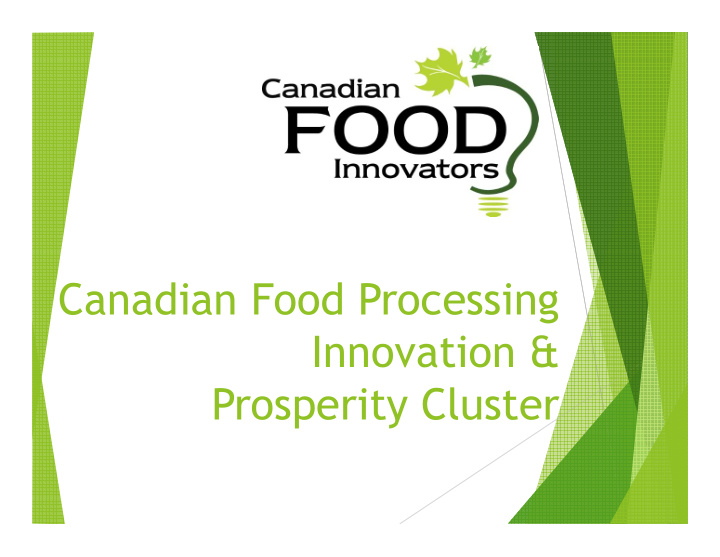



Canadian Food Processing Canadian Food Processing Innovation & Prosperity Cluster
Agriculture and Agri-Food Canada AgriInnovation Program Goals Accelerate the pace of innovation Enhance economic growth Enhance productivity Enhance competitiveness Enhance adaptability and sustainability Assist in capturing opportunities for the sector in domestic and international markets
Canada’s Private Sector Innovation Situation Canada is ranked 26 th on private sector capacity for innovation – a major factor in our overall declining competitiveness Canadian business spending on R&D ranks 22 nd among OECD countries (% of GDP) 22 among OECD countries (% of GDP) Canadian business productivity is ranked 17 th among OECD countries – almost 30% lower productivity levels than U.S. businesses Source: World Economic Forum, OECD
Canada’s Food & Beverage Processing Innovation Ecosystem Notable Strengths & Weaknesses of Ecosystem Weaknesses Strengths High quality human resources Limited availability of resources to navigate Innovation Ecosystem Scientific and technical expertise Pursue iterative vs. radical Entrepreneurial individuals innovations Wealth of basic science Missed opportunities for knowledge commercialization Strong research infrastructure in Branch-plant mentality limits universities information sharing Strong emergence of Difficulty in justifying innovation due entrepreneurs and SMEs focused to traditional metrics of success on innovation (ROI) Well positioned and adaptive in Funding structures do not span crib- operations to-grave In-house innovation capabilities amongst some large processors Able to manage risk while scaling innovation Source: ISED, KPMG
An Agri-Science Cluster aims to mobilize and coordinate a critical mass of scientific Canada’ s Food & Beverage Processing expertise in industry, Sector academia and government It will address several themes that are priorities to the industry Canada’s Canada’s Universities & Federal Food Research Technology Centres Centres
Board of Directors Rotimi Aluko University of Manitoba Louis Falardeau Bonduelle North America Lori Ell UFA Co-operative Ltd. James Farrar Jayeff Partners (Secretary to the Board) Gay Hahn Avalon Dairy Ltd. Joe Lake McCain Foods Limited Chad Mann Amalgamated Dairies Limited Jitendra Sagili Maple Leaf Foods Mark Picard Infraready Products Ltd. David Shambrock Canadian Council of Food Processors Jim Smith BioFoodTech Jason Wortzman Granny's Poultry Cooperative
The CFI Food Processing Cluster 10 projects meeting AAFC criteria 20+ companies / research organizations involved 40+ scientists / researchers involved Durations range from 18 months to 5 years $6.5 million total budget Themes: Themes: Mitigate food safety risk factors Expand sustainable practices in the value chain Advance health and wellness attributes Add more value to raw agricultural inputs Enhance quality in line with customer or consumer need
Project Examples Log Salmonella reduction study on meat products Anti-microbial protection of frozen vegetables and fruit which have been partially dried before freezing by coating and spraying In vitro and in vivo studies for characterization and health effects of newly developed purple wheat products Development of eggshell powder as a functional food ingredient Development of protein hydrolysates and ginseng extracts via high hydrostatic pressure-enzymatic hydrolysis (HHP-EH) technology Development of innovative food products using cavitation technology Development and commercialization strategies for foods enhanced with barley grain ingredients that are produced through a cost efficient dry processing technology
Next Areas of Focus for CFI Innovative applications of: Automation, robotics and sensor technology Flexible manufacturing techniques Water efficient technologies Sanitation technologies that minimize pathogen risk Sanitation technologies that minimize pathogen risk Packaging technologies to reduce non-renewable materials, enhance food safety, and maximize integrity including shelf life
Thank you For more information: David Shambrock Tel: 204-982-6372 ext. 102 Email: dave_shambrock@canadianfoodinnovators.ca
Recommend
More recommend